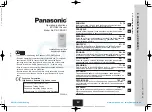
A-202
Standard Photoelectric Sensors
Technical Guide
Glossiness
When light is applied to the sensing object, the reflected light
is generally a mixture of regular reflection components and
diffuse reflection components. Glossiness is directly propor-
tional to the light intensity of the regular reflection compo-
nents. In JIS, the glossiness of a glass plate surface having
1.567 reflectivity is defined 100 as the basis of glossiness.
Glossiness of Typical Object Sensed by E3X-NL11 + E32-
S15
Sensing of Transparent Objects with Rotating Fiber Unit
Mounting Bracket
There are transparent films and transparent plastic objects
that change the direction of polarized light when it passes
through the transparent films and transparent plastic objects.
When E3X-NL senses these transparent films and transpar-
ent plastic objects on glossy background objects, such as
glossy paper or metals, E3X-NL will not sense these objects
smoothly in case of an incorrect angle of the sensor head. The
most suitable angle of the sensor head varies with the trans-
parent object. The angle of the sensor head can be, however,
0° or 45° for the smooth sensing of such transparent objects
due to the characteristic of polarized light. There is no need
for the angle to be midway between 0° and 45°. E39-L109,
which is sold separately, is a mounting bracket that rotates to
angles of 0° or 45° and enables E3X-NL to sense such trans-
parent objects smoothly with its sensing head set at 0° or 45°
without changing the sensing positive.
Fuzzy Teaching Function
E3X-NL in two-point teaching operation will perform fuzzy
computation using the difference in glossiness and the differ-
ence in light energy between the two teaching points to deter-
mine the thresholds setting with E3X-NL. As shown in the
following table, if there is only a small difference in glossiness
but there is a large difference in light energy between the two
teaching points, the thresholds set with E3X-NL will be deter-
mined by the light energy values.
Countermeasures against Teaching Errors Resulted with
Transparent Labels on Sheets
The material of the sheets must not be too glossy.
Nomenclature:
1,000
100
10
Object no.
1
2
3
4
5
6
7
8
9
10
Glossiness
1. White paper
2. Brown corrugated cardboard
3. Paper gummed tape
4. White glossy paper (individu-
al packages for OMRON
sensors)
5. Blue mount paper for label
6. Transparent label on blue
mount paper
7. Glossy plastic
8. Transparent glass (t=1 mm)
9. Gold printing ink (Gold part
of Cabin Mild Box)
10. Metal mirror surface (SUS
mirror surface)
Taught
Difference
in glossiness
between two
teaching points
Taught
Difference
in light energy
between two
teaching points
Discriminating method
Large
Large
Discriminated by glossiness.
Large
Small
Discriminated by glossiness.
Small
Large
Discriminated by light energy.
Small
Small
Discriminated by glossiness. A
teaching error will result if the dif-
ference in glossiness and that in
light energy are both less than the
sensing levels of E3X-NL.
(Example) Metal cylindrical object coated with transparent film
Metal cylindrical object
coated with
transparent film
Sensing head
The object can be sensed smoothly when the
angle of the sensing head is either 0
˚
or 45
˚
.
45
˚
Operation indicator
(orange)
Teaching button
Mode selector
Stability indicator
(green)
Teaching indicator
(red/green)
Operation mode
selector
Difference in glossiness
Large
Discriminated by glossiness
Fuzzy discrimination of glossiness and light energy
Discriminated by light energy
Difference in light energy
Large
Small
Teaching error




























